View in other NatureServe Network Field Guides
NatureServe
Montana
Utah
Wyoming
Idaho
Wisconsin
British Columbia
South Carolina
Yukon
California
New York
Thistle Seedhead Weevil - Rhinocyllus conicus
State Rank Reason (see State Rank above)
Rhinocyllus conicus was introduced from France and Italy into Canada and the United States of America (USA) as a biocontrol agent to control non-native thistles and create the balance of a plant species with their natural predator (Winston et al. 2012 and 2016). The insect naturally spread and became established. Although Rhinocyllus conicus is abundantly found on Musk Thistle and other non-native thistles, it has also been documented on 22 of the 90 native thistle species in the USA. Therefore, Rhinocyllus conicus is no longer approved for re-distribution in the USA. A conservation status rank is not applicable (SNA) because Rhinocyllus conicus is a non-native insect in Montana that is not a suitable target for conservation activities.
General Description
Thistle Seedhead Weevil (Rhinocyllus conicus) is an insect, specifically a type of beetle in the Bark Beetle Family, Curculionidae.
ADULTS: Dark brown or black weevils with yellowish tufts of hairs that given them a mottled appearance in the spring time. With age they lose the tufts of hairs and turn brownish-black. They grow to 6 mm long. Sources: Winston et al. 2012 and 2016
LARVAE: White with brown head capsules, c-shaped bodies, and grow to 4 mm long. Sources: Winston et al. 2012 and 2016
EGGS: Laid on buds and stems. Individual eggs are covered with chewed plant material that darkens with age, and can appear as part of the plant. Sources: Winston et al. 2012 and 2016
Range Comments
Thistle Seedhead Weevil is native to Europe.
INTRODUCTION [Adapted from Winston et al. 2012 and 2016]
Thistle Seedhead Weevil was approved for release in North America to control non-native thistles. In the USA in 1969, Thistle Seedhead Weevil was released on Spiny Plumeless-thistle (Carduus acanthoides), Musk (Carduus nutans), Scotch (failed) (Onopordum acanthium), Italian (Carduus pycnocephalus), Slenderflower (Carduus tenuiflorus), and Milk Thistle (Silybum marianum) plants. Originating from host plant species in France, Thistle Seedhead Weevil was released and redistributed to numerous non-native thistle species in Canada in 1968. Originating from three host plant species in France and Italy, three strains of Thistle Seedhead Weevil were released into the USA in 1969. Releases took place in Montana and Virginia.
Observations in Montana Natural Heritage Program Database
Number of Observations: 19
(Click on the following maps and charts to see full sized version)
Map Help and Descriptions
Relative Density
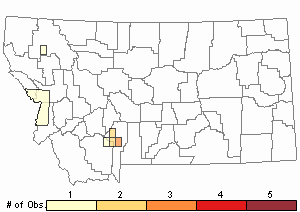
Recency
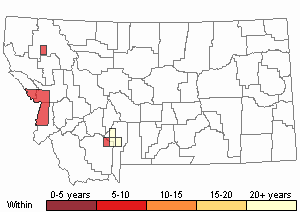
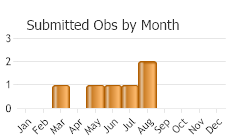
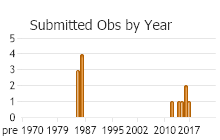
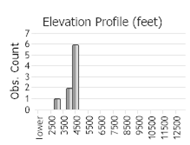 (Observations spanning multiple months or years are excluded from time charts)
(Observations spanning multiple months or years are excluded from time charts)
Habitat
HOST PLANTSThistle Seedhead Weevil prefers thistle species in the genus
Carduus over those in the genus
Cirsium (Winston et al. 2016). In the USA, Thistle Seedhead Weevil is often abundant on Musk Thistle. The weevil can also be found on other non-native thistles such as Spiny Plumeless-thistle, Bull Thistle (
Cirsium vulgare), and Canada Thistle (
Cirsium arvense).
The weevil naturally spread to Bull and Canada thistle plants – and also feeds on native
Cirsium thistles (Winston et al. 2016). After populations established in the USA and Canada it was discovered to feed on many native
Cirsium thistles. Of the 90
native Cirsium species in the USA, 22 have been documented to be predated upon by Thistle Seedhead Weevil (Winston et al. 2016). Predation on native thistles has even occurred in places where non-native thistles are present.
Food Habits
Adult weevils feed on leaves and flower bracts of thistles.
Larvae feed on seeds of thistles.
Ecology
DAMAGE TO PLANTS [Adapted from Winston et al. 2016]
Adult weevils feed on leaves and bracts, creating a characteristic of rounded feed holes over the entire surface of the foliage. This causes minor damage to the thistle.
Larvae feed on seeds. Several larvae typically are found feeding on the same flower head. Plants are not killed, but seed production is reduced. In Canada, larvae of Thistle Seedhead Weevil have been found to destroy over 90% of the flower heads (capitula) on a Musk Thistle plant, reducing seed production by about 50%. For Spiny Plumeless Thistle, larvae were found to reduce seed production in only about 10% of the flower heads because only the early season capitula were attacked. Attacks to Cirsium thistles were reported as even more minor.
Reproductive Characteristics
LIFE CYCLE [Adapted from Winston et al. 2012 and 2016]
There is one generation per year. Adults overwinter and emerge in the early spring. Adults deposit eggs on the involucral bracts of the flower heads, and on the stem. Larvae hatch in late spring to early summer and develop through four larval stages (instars). Larvae burrow into the flower head to feed on the receptacle tissue and developing seeds. Pupation occurs in the flower head during late summer as the seeds mature. Adults emerge for a short time before overwintering in protected places.
Management
BIOLOGICAL CONTROL [Adapted from Winston et al. 2012 and 2016]
A variety of biocontrol agents (insects, fungi, and others) have been brought into North American to control non-native thistle plants. A fair amount of preliminary work and an array of factors must be considered when developing a biocontrol plan for controlling non-native thistles. Readers are encouraged to consult the "Useful Links" and cited literature in this profile.
The use of biological control agents on non-native thistles began in North American with the 1969 importation of Thistle Seedhead Weevil. Thistle Seedhead Weevil was intentionally released in Canada (1968) and the USA (1969) to control exotic thistles – specifically for Musk, Spiny Plumeless, and Scotch (failed) Thistles and other non-native
Carduus,
Onopordum, and (
Silybum) species (Winston et al. 2012 and 2016). Thistle Seedhead Weevil naturally spread to Bull and Canada Thistle species. After establishment, it was discovered that Thistle Seedhead Weevil fed on numerous native thistles in the genus
Cirsium. Therefore,
interstate shipment permits were revoked in 2000, and Thistle Seedhead Weevil is no longer approved for re-distribution for any use. Lessons were learned, and Louda (2000) reviews the information and presents 8 lessons to help guide future biological control efforts.
Melissa Maggio-Kassner is the coordinator for the Montana Biological Weed Control Project. She can be reached at (406) 258-4223 or
mmaggio@missoulaeduplace.orgUseful Links:Central and Eastern Montana Invasive Species TeamMontana Invasive Species websiteMontana Biological Weed Control Coordination Project Field Guide for Biological Control of Weeds in Montana Montana Department of Agriculture - Noxious WeedsMontana Weed Control AssociationMontana Weed Control Association - Weed District ContactsMontana Fish, Wildlife, and Parks - Noxious WeedsMontana State University Integrated Pest Management ExtensionWeed Publications at Montana State University Extension - MontGuidesUseful Links:Central and Eastern Montana Invasive Species TeamMontana Invasive Species websiteAquatic Invasive Species
Stewardship Responsibility
References
- Literature Cited AboveLegend:
 View Online Publication
View Online Publication Winston, Rachel L., Carol Bell Randdall, Rosemarie De Clerck-Floate, Alec McClay, Jennifer Andreas, and Mark Schwarzlander. 2016. Field Guide For The Biological Control of Weeds In The Northwest. August 2016 Reprint. FHTET-2014-08. Forest Health Technology Enterprise Team, University of Idaho Extension and USDA Department of Agriculture.
Winston, Rachel L., Carol Bell Randdall, Rosemarie De Clerck-Floate, Alec McClay, Jennifer Andreas, and Mark Schwarzlander. 2016. Field Guide For The Biological Control of Weeds In The Northwest. August 2016 Reprint. FHTET-2014-08. Forest Health Technology Enterprise Team, University of Idaho Extension and USDA Department of Agriculture. Winston, Rachel, Rich Hansen, mark Schwarzlander, Eric Coombs, Carol Bell Randall, and Rodney Lym. 2012. Biology and Biological Control of Exotic True Thistles. Third Edition, April. FHTET-2007-05. Forest health Technology Enterprise Team, USDA, US Department of Agriculture.
Winston, Rachel, Rich Hansen, mark Schwarzlander, Eric Coombs, Carol Bell Randall, and Rodney Lym. 2012. Biology and Biological Control of Exotic True Thistles. Third Edition, April. FHTET-2007-05. Forest health Technology Enterprise Team, USDA, US Department of Agriculture.
- Additional ReferencesLegend:
 View Online Publication
View Online Publication
Do you know of a citation we're missing? Corr, D.R. 1988. Effects of stress inducing factors on musk thistle (Carduus nutans L,) including--grass competition, Rhinocyllus conicus Froel., terminal flower loss, and insecticides. M.Sc. Thesis. Bozeman, MT: Montana State University. 86 p.
Corr, D.R. 1988. Effects of stress inducing factors on musk thistle (Carduus nutans L,) including--grass competition, Rhinocyllus conicus Froel., terminal flower loss, and insecticides. M.Sc. Thesis. Bozeman, MT: Montana State University. 86 p. De Smet-Moens, H. 1982. The insect fauna of Canada Thistle Cirsium arvense (L.) Scop in southern Montana. M.Sc. Thesis. Bozeman, MT: Montana State University. 51 p.
De Smet-Moens, H. 1982. The insect fauna of Canada Thistle Cirsium arvense (L.) Scop in southern Montana. M.Sc. Thesis. Bozeman, MT: Montana State University. 51 p. Louda, S.M. 1998. Population growth of Rhinocyllus conicus (Coleoptera: Curculionidae) on two species of native thistles in prairie. Environmental Entomology 27(4): 834-841.
Louda, S.M. 1998. Population growth of Rhinocyllus conicus (Coleoptera: Curculionidae) on two species of native thistles in prairie. Environmental Entomology 27(4): 834-841. Louda, S.M. 2000. Rhinocyllus conicus - Insights to Improve Predictability and Minimize Risk of Biological Control of Weeds.
Louda, S.M. 2000. Rhinocyllus conicus - Insights to Improve Predictability and Minimize Risk of Biological Control of Weeds. Louda, S.M. and A.E. Arnett. 2000. Predicting non-target ecological effects of biological control agents: evidence from Rhinocyllus conicus. Proceedings of the X International Symposium on Biological Control of Weeds. 4-14 July 1999. Montana State Univers
Louda, S.M. and A.E. Arnett. 2000. Predicting non-target ecological effects of biological control agents: evidence from Rhinocyllus conicus. Proceedings of the X International Symposium on Biological Control of Weeds. 4-14 July 1999. Montana State Univers McDermott, G.J. 1991. Determination of host races in three insect species attacking Dalmation toadflax and yellow toadflax in North America. M.Sc. Thesis.Bozeman, MT: Montana State University. 43 p.
McDermott, G.J. 1991. Determination of host races in three insect species attacking Dalmation toadflax and yellow toadflax in North America. M.Sc. Thesis.Bozeman, MT: Montana State University. 43 p.
- Web Search Engines for Articles on "Thistle Seedhead Weevil"
- Additional Sources of Information Related to "Insects"





